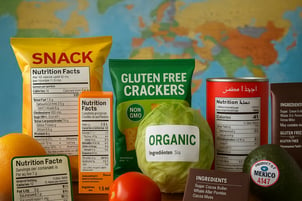Key Differences Between PIM and PLM Systems
Applying Percentage Weighted Formulations in Cosmetics
Cosmetics is a fascinating blend of science and artistry. Think about it – the luxurious feel of a high-end cream, the vibrant colour of a perfect eyeshadow, the long-lasting effect of a favourite lipstick - all of that comes with the help of scientific formulas. Creating these products, ensuring their effective, consistent, and can be made in large quantities, is a complicated procedure.
One of the biggest obstacles that the cosmetic developers face is getting the ingredient measurements correct. Precision is the most important for a product's performance, safety, and even how long it lasts on its shelf. This is where percentage-weighted formulations becomes so significant. They are a way of expressing each ingredient as a percentage of the total mixture, which helps in maintaining accuracy and consistency.
Even tiny variations in the amount of an active ingredient or an emulsifier can have a very big impact on a product's appearance, stability, and even on how well it actually works. For instance, too much preservative could irritate the skin, and in the same way too little could compromise its safety. That's why percentage-weighted formulations are absolute essentials for a successful cosmetic development, whether you're working on a small test batch or scaling up for mass production.
Here, we'll delve into why percentage-weighted formulations are so vital for creating reliable and effective cosmetics? Whether you're a seasoned cosmetic chemist or just starting up in formulation, understanding this method should be helpful for your beauty science. So, let's get started!
Understanding percentage-weighted formulations
Creating a successful cosmetic product starts with creating a formula, and the percentage weight (% w/w) of each ingredient helps in simplifying it. This percentage tells you how much each ingredient contributes to the end-product's overall weight. Using these helps keep the formula consistent, no matter the scale of production. Whether you're making a small 10-gram test sample or a massive 1,000-kilogram batch, the ratios of the ingredients stay the same, thus the product consistency. This consistency is of very important because even a slight change can affect a product's texture, stability, and how well it performs.
Regulatory bodies also require formulas to be listed in percentages for clarity and safety. This helps companies comply with international standards and makes global marketing much smoother as well.
By mastering percentage-weight formulations, creators can develop cosmetics that are both reliable and effective.
The steps to build the Percentage weighted formulations involves:
-
Weighing the individual ingredients.
-
Arriving at sum total of all ingredients in the formula.
-
Compute the percentage of the individual ingredients to the total sum.
Once the percentages of individual ingredients are derived, use them to scale the formula to the required batch size.
Weighing the individual ingredients
Cosmetic formulations rely on precise mass measurements of ingredients, not volume, to ensure accuracy, as ingredients vary in density.
To achieve accurate cosmetic formulations, ingredients can be weighed directly on a scale, providing precise mass measurements and accounting for variations in density that volume cannot capture.
| Ingredient | Weight (g) |
| Water | 55 |
| Glycerin | 10 |
| Shea butter | 15 |
| Cetyl Alcohol | 5 |
| Emulsifying wax | 10 |
| Preservative | 5 |
Another approach to this is with liquid ingredients measured by volume, here specific gravity or density is used to convert those volume measurements into the necessary mass units (grams, pounds, etc.) for accurate formulation.
Converting ingredients into percentages
Finding the percentage of each ingredient in a 100-gram mixture is pretty straightforward:
-
Divide the weight of each ingredient (in grams) by the total weight of the mixture (100 grams).
-
Multiply the result by 100 to get the percentage.
| Ingredient | Weight (g) | Percentage (%) Calculation | Percentage (%) |
| Water | 55 | (55/100)× 100 | 55% |
| Glycerin | 10 | (10/100)× 100 | 10% |
| Shea butter | 15 | (15/100)× 100 | 15% |
| Cetyl Alcohol | 5 | (5/100)× 100 | 5% |
| Emulsifying wax | 10 | (10/100)× 100 | 10% |
| Preservative | 5 | (5/100)× 100 | 5% |
| Total | 100 gm | 100% |
Because the total weight is 100 grams, the weight of each ingredient directly reflects its percentage in the final product. For example, if an ingredient weighs 55 grams in a 100-gram mixture, its percentage is (55g / 100g) x 100% = 55%. This method makes sure that the total percentage of all ingredients always adds up to 100%, giving you an accurate picture of the complete formulation.
Scaling percentage weighted cosmetic formulations
Let's say you want to scale up the previously mentioned 100-gram formulation to a 380-gram batch. for that, first, you'd calculate each ingredient specification’s new weight by multiplying the percentage of it with the new batch weight.
| Ingredient | Percentage (%) | New Weight Calculation | New Weight (g) |
| Water | 55% | 55/100 × 380 | 209 |
| Glycerin | 10% | 10/100 × 380 | 38 |
| Shea butter | 15% | 15/100 × 380 | 57 |
| Cetyl Alcohol | 5% | 5/100 × 380 | 19 |
| Emulsifying wax | 10% | 10/100 × 380 | 38 |
| Preservative | 5% | 5/100 × 380 | 19 |
| Total | 100% | 380 gm |
Validating the formula
After you've created a cosmetic formula with specific percentages, it's absolutely vital to double-check its accuracy and safety. Here are the essential steps:
-
Knowing the Ingredients: Understand the ingredient specifications well and the quantities to be used by referring the safety data sheets.
-
Check Ingredient specification’s weights and percentages: Verify that each ingredient weight exactly corresponds to its given percentage. For instance, a 5% ingredient in a 1,000-gram end-product should weigh 50 grams. Some ingredients carry restricted usage, too much or too little could negatively impact a formula or unsafe at particular levels.
-
Confirm the formula composition totals 100%: In a formulation: All the components must add up to 100%. Make sure that the percentages of each ingredient's sum up to 100%, this ensures that the formulation is balanced and accurate.
For example, a moisturiser might consist of 70% water, 20% oils, and 5% emulsifiers, leaving 5% for things like preservatives or fragrances. Errors in these calculations can impact the product's performance and stability. So, it's absolutely crucial for formulators to meticulously double-check their calculations to ensure everything is complete and correct.
Benefits of using percentage weighted formulations
Percentage-weighted formulations can help in quick turn-around how cosmetics are made as they streamline processes, enhance product quality, and also help companies comply with industry regulations by expressing ingredients as a percentage of the total weight. The two most important benefits of this are-
-
Consistent Formula Representation: Percentage-weighted formulations help maintaining all-important consistent ratios, ensuring that formulas are easily represented, validated and verified.
-
Simplified Compliance and Labelling: By using percentage-based labelling, companies can easily align with international standards, which actually simplifies the approval process and builds customer trust through clear and accessible information.
Cloud PLM software like Plevenn, with its Ingredients Management and Cosmetics Formulation tools can significantly assist with formulation and recipe management, and help you in reducing the possibility of errors.
Feb 28, 2025 8:20:01 PM








